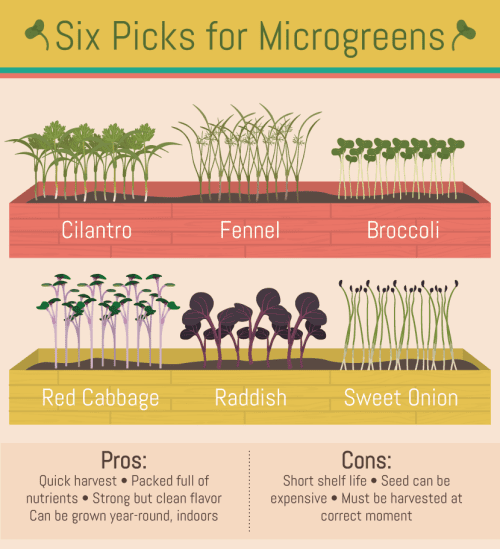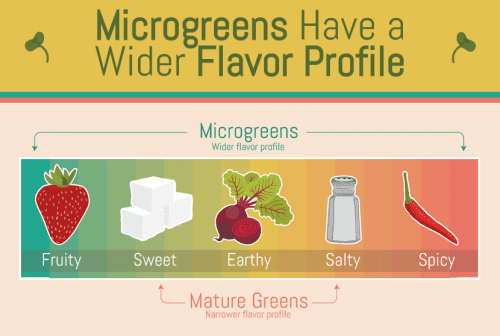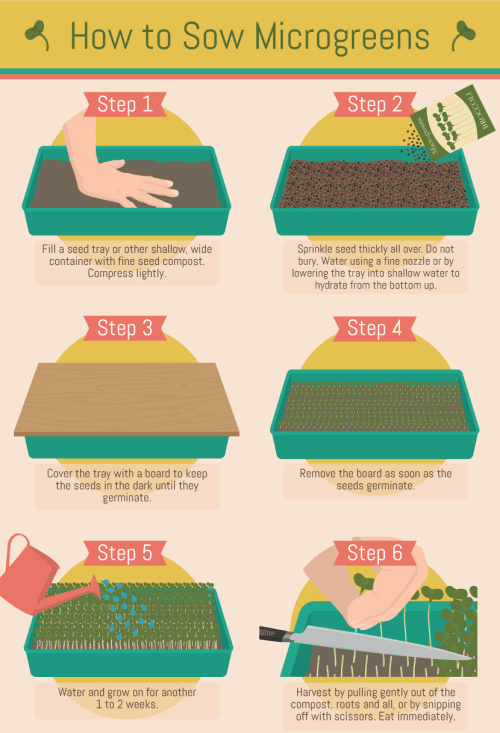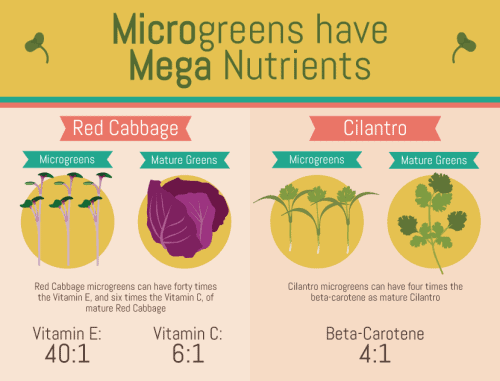Microgreens are the perfect crop for new gardeners and old hands alike. For new gardeners they offer almost instant results and near-guaranteed success. For gardeners who have been around the block a few times they are a great way to grow familiar crops in a different way, to harvest maximum flavour and nutrients. They can also be sown indoors throughout the winter, making for a great crop when all else is dormant, but gardening enthusiasm is still high.
Microgreens are tiny seedlings, sown thickly, and harvested young. The main reason to grow them is for the incredible flavour. Microgreens taste like a concentrated version of their grown-up selves, without the baggage that accrues with maturity: there is little bitterness and a strong clear flavor. They also look good and are used by chefs to add a sprinkling of color to their dishes.

Microgreens for Strong Tastes
Some micros are particularly punchy and strong. If you are looking for a microgreen that you can’t miss, then look to the herbs first. Cilantro, basil, chives, fennel, sorrel, and dill all make beautiful microgreens. Basil can be tricky when grown traditionally so it’s a great candidate for microgreens. It sulks at a lack of heat, wilts at too much or too little water, and generally plays the diva at every little slight. When grown as micros it just doesn’t have time for dramatics: it’s unlikely to hang around long enough to rot off because of your watering regime. It just germinates and is whipped out of the soil.
Not all the stronger flavors are herbs. Mustards make good, strong microgreens, as do radishes and rocket or arugula. Arugula – like basil – can be tricky to grow in the traditional manner: its leaves are preyed on by flea beetles and end up full of holes. They end up edible but not especially appetizing. Flea beetles are still attracted to them when they’re grown as micros, but they just don’t have time to find them. So this is a way of getting beautifully clean leaves that you actually want to eat.

Microgreens for Crunch
While most micros are grown for their hit of strong flavor, it is also worth growing some milder leaves for their gentler flavors and delicious crunch. Pea shoots are good for this: the juicy, crunchy shoot tastes exactly like lovely fresh peas. Sunflower likewise makes a lovely fresh, crunchy shoot, as do pak choi and fava bean shoots.
Microgreens for Color
Many chefs have started using microgreens, and while this is certainly for the note of flavor they bring to a dish, there is an element of theater about them too. They look beautiful, particularly those with strong coloring. Some of the best for imparting a splash of color include purple basil, red amaranth, red cabbage, kale, rainbow chard, and oriental mustards. The ferny, feathery shoots such as dill and fennel look beautiful in their own way. The caveat is to make sure the flavor of your microgreen goes well with your dish: very few – such as red amaranth – are neutral in taste and can be used for prettiness alone.
Getting Enough Seed
One of the main issues with growing microgreens is getting enough seed. You will need to use it generously, spreading a thick layer across a seed tray, to get enough microgreens to be worth bothering with. If you were to use the usual packets of seed bought for growing vegetables and herbs the cost would be prohibitive, so look for alternatives.
Herb seed sold for cooking can be much cheaper and is worth trying, though it is possible that it may not have high germination rates. Some companies sell cheap bulk seed for sprouting in sprouters; it’s worth looking through their ranges and seeing which ones can also be used for microgreens. A final option is to save your own seed. When a cilantro or arugula plant that you are growing for leaves goes to flower, don’t automatically pull it up. Leave it and let it develop into seed that you will be able to gather in great handfuls for free. You can do this with every microgreen you grow: sow a few plants in the traditional manner, pricking out to one seedling per pot, and then plant out and grow on to maturity. You can harvest the leaves of these plants as usual but when they start to go to flower, let them, and then later return to harvest the seed.

Using Microgreens
Microgreens are a very delicate ingredient, and so are not suited to slow cooking, or indeed to any cooking at all. They are a finishing touch, for sprinkling onto dishes just before serving. In fact, it is a good idea to harvest them just before you intend to eat them: they are so small that they will quickly wilt and lose their loveliness if picked and left lying around.
If you do need to harvest far in advance of eating, lay a piece of moist kitchen towel in the bottom of a clean ice cream tub or Tupperware and sprinkle the harvested microgreens lightly across it before putting on the lid and storing in the fridge. They will keep for a few hours this way. Then have fun sprinkling basil microgreens onto tomato salads, fennel micros onto baked fish, and a whole mix of variously flavored and colored micros to jazz up a salad. They can even work on sweet dishes: basil micros are particularly lovely with fruit and cream desserts, for instance.

Microgreens are never going to fill you up, but they deliver well above their weight in terms of flavor and nutrients, and will go a long way toward making your dishes more beautiful and sparkling, with that little extra crunch.
Lia Leendertz is an award-winning garden writer based in the UK. She is a regular writer for The Guardian and The Telegraph. She has a town garden and an allotment in Bristol, England, and loves growing flowers, vegetables and fruit. Check out more from Fix.com.



 Follow Us On Instagram
Follow Us On Instagram
